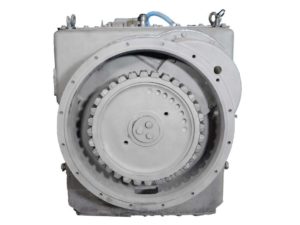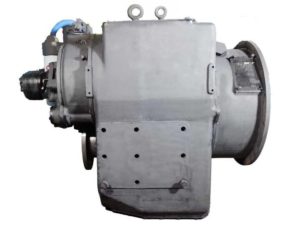Routine maintenance is essential to extending the service life and ensuring the reliability of the Twin Disc MG-540 marine transmission. This transmission operates under heavy-duty marine conditions and requires consistent inspection, oil management, and hardware checks to avoid costly failures and downtime. This section outlines a full 5,000-word scheduled maintenance program including daily, weekly, and long-term maintenance cycles. It also details procedures for inspecting key systems such as zincs, seals, oil filters, and driveline components.
Daily, Weekly, and 90-Day Intervals For Twin Disc MG-540 Marine Gear
Daily Maintenance (Every 10 Operating Hours)
Daily checks should be completed before engine startup and again after shutdown. These are the foundation of any maintenance program.
| Task | Description |
| Oil Level Check | Check with engine off and again at idle in neutral once warm. Confirm between “LOW” and “FULL” marks. |
| Visual Leak Inspection | Look for oil weeping from gaskets, fittings, or breather. |
| Filter Indicator | Check pressure differential or clog indicators on hydraulic filter housing (if equipped). |
| Breather Cap | Ensure free ventilation; clean if oil mist buildup is present. |
| Control Functionality | Ensure smooth actuation of shift controls and no delay in clutch engagement. |
Weekly Maintenance
Performed every 50 hours or weekly, this interval includes additional checks that catch problems early.
- Inspect Mounting Bolts: Torque check on bellhousing and output brackets.
- Wipe and Examine Output Coupling: Watch for oil sling or metal debris.
- Check Control Cable or Wiring: Look for corrosion, damage, or fraying.
- Inspect Oil Cooler Lines: Confirm all hose clamps are tight; check for hose chafing or cracks.
- Confirm Pressure Gauge Accuracy: Use external gauge if internal panel readings seem off.
90-Day Inspection Cycle
Every three months or 250 hours, inspect systems that are more vulnerable to electrolysis, vibration, or marine exposure.
- Check Heat Exchanger Zinc Rods
- Remove and inspect sacrificial zincs installed at cooler inlet/outlet.
- If more than 50% depleted, replace immediately.
- Clean minor deposits with a wire brush.
- Investigate galvanic corrosion if depletion occurs rapidly.
- Inspect Shaft Seals and Couplings
- Look for evidence of bilge water intrusion around output shaft seals.
- Use water pump grease (NLGI No. 2) via grease fitting every 100 hours.
- Examine Torsional Coupling
- Check for bushing deterioration, excessive movement, or audible “rattle” under load.
- Check for bushing deterioration, excessive movement, or audible “rattle” under load.
- Inspect Electrical Grounding
- Faulty or missing grounds can accelerate galvanic corrosion in heat exchangers and control electronics.
Heat Exchanger Zinc Inspection and Replacement For Twin Disc MG-540 Marine Gear
The optional Twin Disc XB1618G (raw water) and XB1618H (fresh water) heat exchangers come equipped with zinc anode rods. These rods protect the cooler’s metal surfaces from corrosion due to galvanic activity in seawater environments.
Zinc Rod Maintenance Guidelines
| Inspection Interval | Action |
| Every 90 Days | Remove, inspect, and clean rods |
| More than 50% disintegrated | Replace immediately |
| Rod coated with foreign matter | Clean with brass brush; do not acid wash |
Zinc Removal Procedure
- Shut Down and Cool: Allow transmission and exchanger to reach ambient temperature.
- Isolate Cooling System: Close raw water intake valves.
- Remove Zinc Plug: Use wrench to remove zinc plug at inlet/outlet.
- Inspect and Replace: Compare rod to a new one; if more than half depleted, replace.
- Reinstall and Torque: Clean threads, apply marine thread sealant, and torque to 20–25 lb-ft.
Excessive zinc depletion may indicate:
- Electrolysis from poor bonding or ground loops
- Stray current from faulty battery isolation
- Poor hull anode maintenance
Oil Change Frequency and Filter Replacement For Twin Disc MG-540 Marine Gear
A consistent oil change and filtration routine is the single most important aspect of marine transmission health.
Oil Type and Capacity
- Capacity: 17.25 U.S. gallons (65.3 liters)
- Type: SAE 30 or 40 API CD/CC engine oil or TO-2 compliant hydraulic fluid
- Operating Temp Range: 150–200°F (65–93°C)
Recommended Intervals
| Unit Condition | First Oil Change | Filter Check | Full Service Interval |
| New Transmission | 50 hours | 50 hours | Every 1,000 hours or 6 months |
| Rebuilt Transmission | 8 hours (filter only) | 8 hours (filter) | Every 1,000 hours or 6 months |
| Normal Use | N/A | N/A | 1,000 hours or sooner if needed |
Filter and Strainer Service
- Main Filter Element: Twin Disc #1016052
- Replace with each oil change
- Replace with each oil change
- Suction Strainers:
- Clean at every oil change
- Located in oil suction tubes below pump housing
Draining Procedure:
- Warm up transmission to operating temperature.
- Remove drain plug from base of housing and allow full drain.
- Clean and reinstall plug with new O-ring.
- Refill through top cover with measured volume.
Inspection of Input/Output Seals, Mounting Hardware, and Driveline
Output Shaft Seal (Every 100 Hours or 3 Months)
- Lubricate via Zerk Fitting: Use lithium-based grease NLGI No. 2
- Inspect for Weeping or Bilge Water Intrusion:
- Signs include oil sheen, drip lines, or moisture near seal carrier
- Replace immediately if emulsified oil is observed
Mounting Hardware
| Checkpoint | Frequency | Action |
| Bellhousing Bolts | Weekly | Torque check, look for elongation or cracks |
| Engine Mounts | Monthly | Inspect rubber dampers and washers |
| Output Bracket | Weekly | Check for cracks or stress lines |
Vibration from misaligned or loose mounts can transfer into the gear, damaging seals and internal bearings.
Driveshaft and Coupling
- Visual Coupling Check: Look for corrosion, bolt stretch, or worn bushings
- Shaft Runout Test: Use dial indicator; should not exceed 0.005″
- Flexible Coupling Inspection: Check for radial cracks or rubber delamination
Replace any shaft hardware that shows signs of fretting, elongation, or discoloration.
Summary of Maintenance Tasks and Intervals For Twin Disc MG-540 Marine Gear
Component |
Task |
Interval |
| Oil Level | Check and top off | Daily (Every 10 Hours) |
| Filters | Replace (PN 1016052) | First 50 hrs; then every 1,000 hrs |
| Suction Strainers | Clean and inspect | Every 1,000 hrs or with oil |
| Zinc Rods | Inspect and replace if 50% depleted | Every 90 Days |
| Output Seals | Grease and inspect | Every 100 Hours |
| Bellhousing Bolts | Torque check | Weekly |
| Mounting Hardware | Inspect for stress/failure | Weekly/Monthly |
| Coupling Alignment | Check with dial indicator | Every 90 Days or after overhaul |
| Pressure Testing | FWD, REV, and NEUT | Every 500 Hours |
| Heat Exchanger | Flush and inspect | Every 6 Months |
| Oil Cooler Lines | Check for corrosion/cracks | Weekly |
Long-Term Maintenance: Overhaul Planning
Twin Disc recommends aligning transmission overhaul intervals with the vessel’s engine overhaul schedule.
- Replace:
- All seals, o-rings, gaskets, and clutch plates
- Bearings with any pitting, noise, or play
- Inspect:
- All gears for wear and discoloration
- Pinion shafts and thrust washers
- Consider replacing:
- Heat exchanger
- Hydraulic hoses
- Electronic control components if 10+ years old
Videos About Twin Disc Transmissions
6 Reasons Your Twin Disc Transmission Has Low Oil Pressure
7 Reasons Your Twin Disc Transmission Is Overheating
3 Reasons Your Clutch Plates in Your Twin Disc Transmission Are Making Excessive Noise
Bull Gear On A Twin Disc Transmission
Rebuilt Twin Disc Transmissions



 Free US Calls: 1-888-433-4735
Free US Calls: 1-888-433-4735 International: 305-545-5588
International: 305-545-5588


